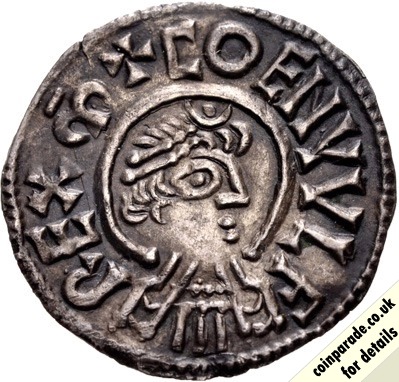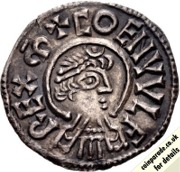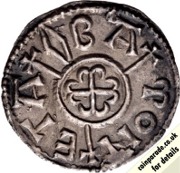
 The 810 Penny - Coenwulf of Mercia
The 810 Penny - Coenwulf of MerciaSilver Penny of King Coenwulf of Mercia. Diameter 21mm and weighs 1.38g. Struck around 810-821 at the Canterbury Mint. Moneyer was Oba. SCBC 916.
The Obverse shows a bust of Coenwulf with the legend 'COENVVLF REX' meaning King Coenwulf.
 The Reverse has a Cross Moline with legend 'OBA MONETA' showing the moneyer (the one allowed to make the coins) was Oba, a moneyer from Canterbury.
The Reverse has a Cross Moline with legend 'OBA MONETA' showing the moneyer (the one allowed to make the coins) was Oba, a moneyer from Canterbury.Image credit: CNGCoins
Mintage: Not known
Minted at Provincial mints
More information (monarch, year, mint, country, category) can be found below coin listings.
Below are some coins currently being offered on eBay. As an eBay Partner, We may be compensated if you make a purchase.
List items on:
List items on:
Coenwulf of Mercia (0796-0821)
Classification: ANGLO-SAXON, Kings of Mercia.Coenwulf, Coenwulf of Mercia, also spelled Cenwulf, Kenulf, Kenwulph or Coenulfus (Latin) was the King of Mercia from December 796 until his death in 821. Birth date is not known.
Category: Penny
The Penny is one of the most famous British coins. The coin itself has been around since 600AD and at various times has been struck in silver, copper and bronze. Originally split into halfpennies and farthing, it is now itself the least denomination coin currently in circulation. Made from copper (actually copper plated steel). Originally there were 12 pennies in one shilling and 240 pennies in £1; since decimalisation in 1971 there are 100 new pence in one pound.
Composition: Early pennies were Silver, then Copper, Bronze and Copper coated steel.
Which Mint: Provincial mints
Not all mints are located in a single place. From the Roman days through to the middle ages it was easier to have local moneyers (trusted people who were allowed to mint coins) rather than make the coins centrally and then have the security and logistics problem of distribution.There were often dozens of mints, sometimes all making the same coin. The variations and mintmarks are exciting for numismatists, although sometimes it takes an expert to analyse them.
Most English Provincial Mints began to close after 1279 when the Royal Mint opened The Tower Mint (called so as it was housed at the Tower of London), although some continued working for much longer. The central mint gave the King and the Master of the Royal Mint much more control over the production and quality of English coinage.
Country of Origin: United Kingdom
The United Kingdom (UK) is the Union of England, Scotland, Wales and Northern Ireland. It is often refered to as Great Britain (GBR). It has a long, rich history. The orignal coinage was Pounds, Shillings and Pence but since decimalisation on 15 February 1971, it is £1 = 100p, that is One Pound = 100 pence. The coinage of the UK is also a long history, the Royal Mint being established as long ago as 886AD when coins were hammered. Today there is perhaps 30 billion coins in circulation, and many (numismatic) collectors coins and sets are issued frequently in gold, silver and other metals.








